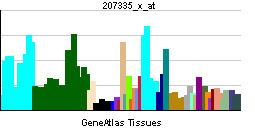Entrez 521 | Ensembl ENSG00000169020 | |
 | ||
Aliases ATP5I, ATP5K, ATP synthase, H+ transporting, mitochondrial Fo complex subunit E External IDs HomoloGene: 136813 GeneCards: ATP5I | ||
ATP synthase subunit e, mitochondrial is an enzyme that in humans is encoded by the ATP5I gene.
Mitochondrial ATP synthase catalyzes ATP synthesis, utilizing an electrochemical gradient of protons across the inner membrane during oxidative phosphorylation. It is composed of two linked multi-subunit complexes: the soluble catalytic core, F1, and the membrane-spanning component, F0, which comprises the proton channel. The F1 complex consists of 5 different subunits (alpha, beta, gamma, delta, and epsilon) assembled in a ratio of 3 alpha, 3 beta, and a single representative of the other 3. The F0 seems to have nine subunits (a, b, c, d, e, f, g, F6 and 8). This gene encodes the e subunit of the F0 complex.
In yeast, the FO complex E subunit appears to play an important role in supporting F-ATPase dimerisation. This subunit is anchored to the inner mitochondrial membrane via its N-terminal region, which is involved in stabilising subunits G and K of the FO complex. The C-terminal region of subunit E is hydrophilic, protruding into the intermembrane space where it can also help stabilise the F-ATPase dimer complex.
